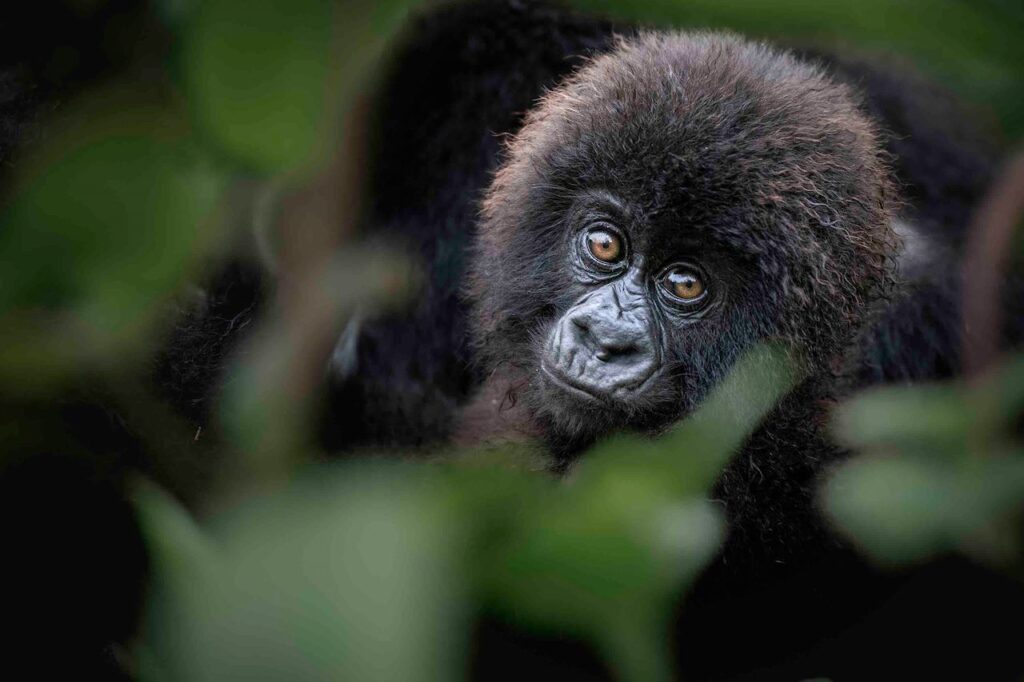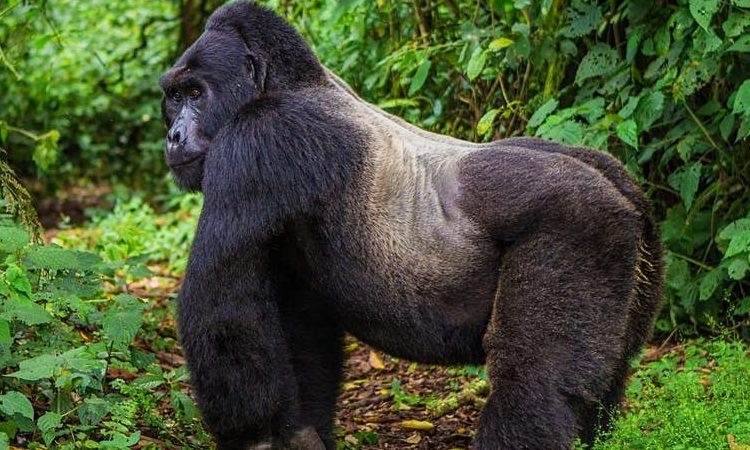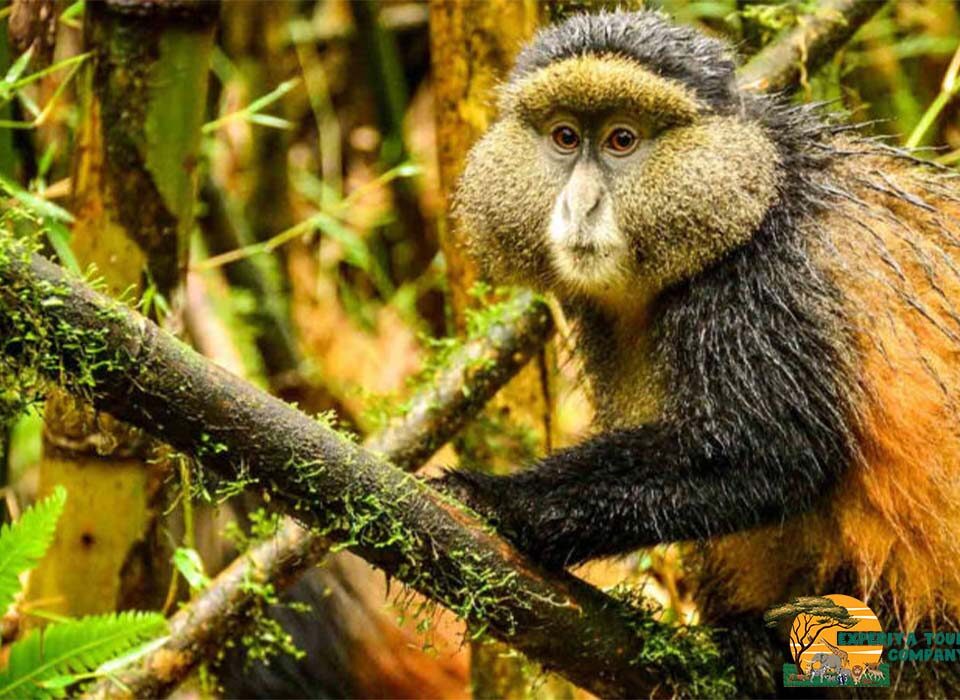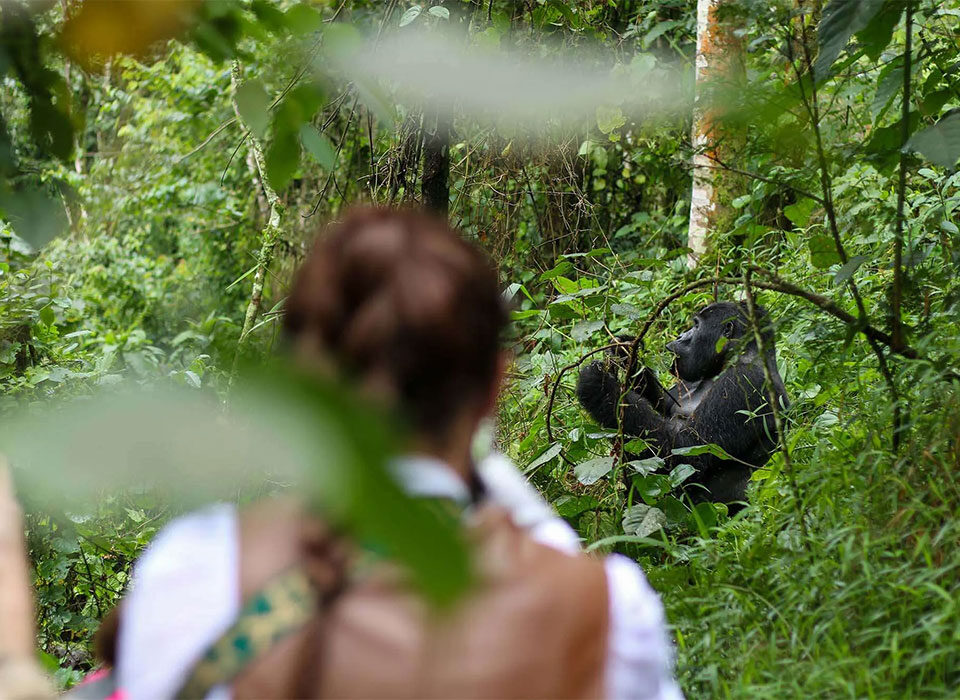
Visiting Sipi Falls in Uganda
October 11, 2025
How much is a gorilla trekking permit in Uganda?
October 22, 2025Where can I trek gorillas in Uganda?
Deep in the emerald heart of Africa lies one of the world’s most awe-inspiring wildlife encounters — the mountain gorilla trek. Uganda, known as the “Pearl of Africa,” offers travelers a rare opportunity to come face-to-face with these majestic creatures in their natural habitat. Gorilla trekking here is not just a wildlife experience; it’s an emotional journey into the mist-shrouded jungles where silence speaks volumes, and every rustle of leaves could mean the presence of a silverback.
In this comprehensive guide, we’ll explore where you can trek gorillas in Uganda, what makes each destination unique, the best time to visit, and why this once-in-a-lifetime experience belongs on your travel bucket list.
The Gorilla Trekking Heartlands of Uganda
Uganda is blessed with two main destinations for gorilla trekking: Bwindi Impenetrable National Park and Mgahinga Gorilla National Park. These two UNESCO-recognized sanctuaries are home to nearly half of the world’s remaining mountain gorillas — a population estimated at just over 1,000 individuals. Each park offers its own atmosphere, terrain, and charm, ensuring no two treks are ever alike.
1. Bwindi Impenetrable National Park — The Ultimate Gorilla Trekking Destination
Located in southwestern Uganda, Bwindi Impenetrable National Park is the crown jewel of gorilla trekking. Spanning over 331 square kilometers of dense rainforest, this ancient ecosystem is one of Africa’s oldest and most biologically diverse habitats. The word “Impenetrable” couldn’t be more fitting — tangled vines, moss-draped trees, and misty ridges make this forest a thrilling challenge for trekkers.
A UNESCO World Heritage Site
Bwindi was declared a UNESCO World Heritage Site in 1994, a recognition of its exceptional biodiversity. Beyond gorillas, it harbors over 350 bird species, 200 butterfly species, and more than 120 mammals. But the star residents are undoubtedly the mountain gorillas, which live in habituated family groups accessible to visitors.
Gorilla Trekking Sectors in Bwindi
To manage tourism and conservation effectively, Bwindi is divided into four main trekking regions, each with its own habituated gorilla families and unique scenery.
Buhoma Sector (North)
Buhoma was the first area opened for gorilla trekking in Uganda, dating back to 1993. It’s the most popular sector because it combines convenient access, comfortable lodges, and rewarding trails. Trekkers here can encounter families like the Mubare, Habinyanja, or Rushegura groups. The terrain is slightly less challenging, making it suitable for first-time trekkers.
Rushaga Sector (South)
Rushaga boasts the highest number of habituated gorilla families, offering a higher chance of permit availability. It’s also the only sector where visitors can participate in the Gorilla Habituation Experience — a unique, four-hour encounter that lets you observe researchers and trackers as they gradually acclimate wild gorillas to human presence.
Nkuringo Sector (Southwest)
Nkuringo is known for its steep terrain and rewarding views of the Virunga Volcanoes. Though physically demanding, the experience is deeply fulfilling. The Nkuringo family was one of the first groups habituated here, and their lush territory offers one of the most scenic trekking backdrops in Uganda.
Ruhija Sector (East)
Ruhija is the quietest and least visited sector, ideal for travelers seeking solitude. It lies at a higher altitude, offering cooler conditions and breathtaking panoramic views. Ruhija is also home to the Bitukura and Oruzogo gorilla families and provides excellent bird-watching opportunities alongside trekking.
What to Expect During the Trek
A typical gorilla trek in Bwindi starts early in the morning after a briefing at the park headquarters. Trekkers are divided into small groups (a maximum of eight people per family) and led by armed rangers and trackers who know the forest intimately. The hike can last anywhere from 1 to 6 hours, depending on the gorillas’ location.
Once you find the gorillas, you’re allowed to spend one unforgettable hour observing them — a moment that many describe as deeply spiritual. Watching a mother cradle her infant or a massive silverback beat his chest amid the jungle echoes is a memory that stays etched forever.
2. Mgahinga Gorilla National Park — The Smaller, Scenic Alternative
Nestled in Uganda’s southwestern corner, Mgahinga Gorilla National Park is part of the larger Virunga Conservation Area, which also spans Rwanda’s Volcanoes National Park and the DRC’s Virunga National Park. Though smaller in size (just 33.7 square kilometers), Mgahinga packs a mighty punch for its visitors.
Home of the Nyakagezi Gorilla Family
Mgahinga hosts a single habituated gorilla family known as the Nyakagezi Group. What makes them special is their distinct personality and the relative ease of trekking them. They often roam within a more predictable range, making encounters shorter and less strenuous compared to Bwindi.
In the past, this group was known to cross borders into Rwanda and Congo, but in recent years, they have settled more permanently in Uganda, offering reliable sightings for trekkers.

A Park of Volcanoes and Golden Monkeys
Mgahinga is not just about gorillas. It’s where “Gold meets Silver,” as the park slogan proudly declares — a reference to the chance of spotting both golden monkeys and silverback gorillas in the same landscape. The park sits on the slopes of three dramatic volcanoes — Mount Muhabura, Mount Gahinga, and Mount Sabyinyo — creating breathtaking backdrops for photos and an adventurous setting for hikers.
Visitors can also combine gorilla trekking with volcano climbing, golden monkey tracking, or cultural encounters with the Batwa pygmies, the forest’s original inhabitants.
The Cost of Gorilla Trekking in Uganda
As of 2025, a gorilla trekking permit in Uganda costs USD 800 per person, allowing one hour of interaction with a habituated family. For those seeking a deeper experience, the Gorilla Habituation Experience in Rushaga costs USD 1,500, giving visitors up to four hours with a semi-habituated group.
Compared to Rwanda’s USD 1,500 standard permit, Uganda offers a more affordable yet equally enriching experience, often coupled with longer treks and more diverse landscapes.
Best Time to Trek Gorillas in Uganda
Gorilla trekking is possible all year round, but the best time to visit is during Uganda’s dry seasons — from June to September and December to February. During these months, trails are less muddy, and the forest paths are easier to navigate.
However, the rainy seasons (March to May and October to November) have their own advantages: fewer tourists, greener vegetation, and excellent opportunities for photography as mist swirls through the jungle. Just be prepared for more challenging hikes.
Fitness and Preparation
While you don’t need to be an athlete, a moderate level of fitness is essential. Trekking through Bwindi’s rugged terrain can involve steep climbs, slippery paths, and high humidity. Hiring a local porter is highly recommended — not only do they help carry your bag and assist on steep slopes, but your contribution directly supports the surrounding communities.
You’ll also need sturdy hiking boots, waterproof clothing, a walking stick (provided at the park), and plenty of water. Most importantly, bring patience and an open heart; nature works on her own schedule, and the reward is well worth the effort.
Beyond the Gorillas — What Else to Explore
Uganda’s southwestern region is a tapestry of scenic beauty and cultural encounters that extend far beyond gorilla trekking. After your trek, you can unwind at Lake Bunyonyi, a serene highland lake dotted with 29 islands — perfect for canoeing and relaxation. You can also visit Queen Elizabeth National Park for tree-climbing lions or head north to Kibale National Park for chimpanzee tracking.
In short, Uganda allows you to combine multiple primate experiences in one itinerary, giving it a distinct advantage over other gorilla destinations.
Responsible Tourism and Conservation
Gorilla trekking in Uganda is one of the world’s greatest conservation success stories. Permit fees directly fund conservation efforts and community development. Every trekker plays a role in safeguarding the gorillas’ future — by choosing ethical operators and following park rules (keeping a safe distance, avoiding flash photography, and not visiting when sick).
The Uganda Wildlife Authority (UWA) strictly limits daily trekking numbers to protect the gorillas from stress and disease. This ensures that each encounter remains intimate and sustainable for generations to come.
Why Trek Gorillas in Uganda Instead of Rwanda or DRC?
While Rwanda and the Democratic Republic of Congo also offer gorilla trekking, Uganda strikes the perfect balance of affordability, accessibility, and diversity. Here, you get two national parks to choose from, rich add-on safaris, warm hospitality, and breathtaking landscapes that go beyond gorillas.
Whether you choose Bwindi’s mystical rainforests or Mgahinga’s volcanic slopes, Uganda promises an unforgettable adventure in the company of some of our planet’s most extraordinary primates.
Plan Your Gorilla Trekking Adventure with Experiya Tour Company
If you’re dreaming of standing in the mist of the forest, meeting a silverback eye-to-eye, and experiencing the heartbeat of Africa in its purest form, it’s time to plan your journey with Experiya Tour Company.
Experiya is a trusted Ugandan safari operator specializing in tailor-made gorilla trekking tours, wildlife safaris, and cultural experiences. Their professional guides, well-crafted itineraries, and deep local knowledge ensure that your journey is seamless from start to finish. Whether you want a luxury escape or an adventurous expedition, Experiya will handle every detail — from gorilla permits to lodge bookings and transport — so you can focus on what truly matters: the experience itself.




